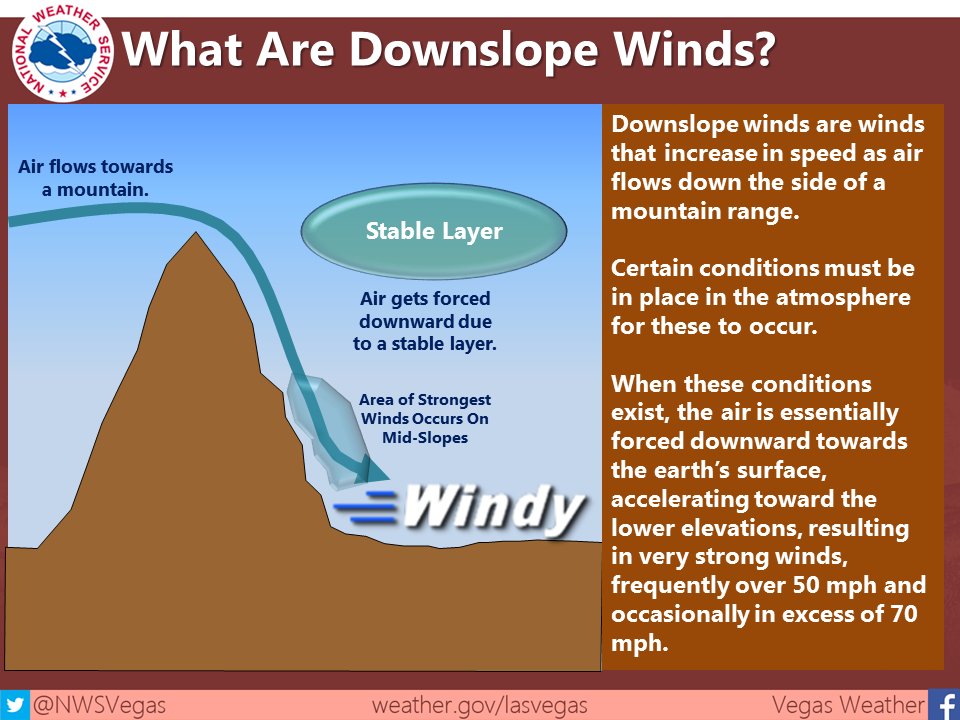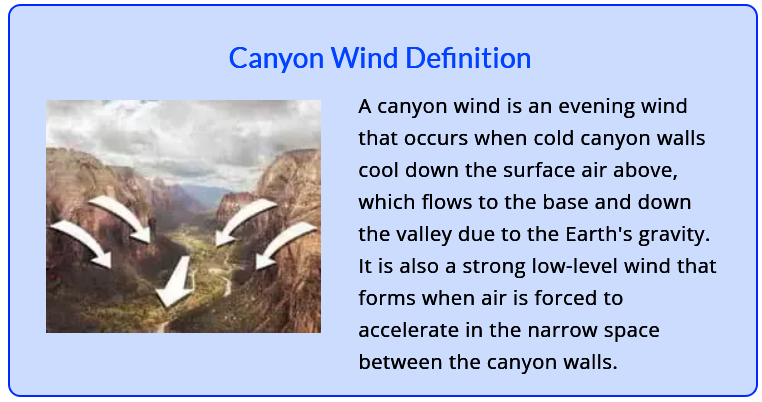Wind Types
Source: OwnYourWeather.com
Strong winds are nothing new or rare in a desert environment, where rapid heating and the mixing that accompanies them can boost breezes into the 15 to 20 mph range, especially during summer. But the Albuquerque metro area, because of its topography (i.e., especially the mountain ranges running to the east of the city) and location in New Mexico has a certain types of wind that has the capacity kick up wind speeds into the 30 mph range, with gusts up to 45 mph. They also have the capacity to foment precipitation and in many cases, limit visibility by stirring up dust.
Downslope Winds

Drainage Winds
Cold-air-runoff winds that are produced when air in contact with terrain surfaces is cooled and flows downslope and/or downvalley. Over even gently sloping topography, drainage winds also refer to gravity winds that drain cold air into frost hollows, river valleys, and other lower-lying terrain.
Canyon Winds Defined
Canyon winds are unique since their structure allows them to create two distinctly different types of winds with their own characteristics. Also known as mountain breezes and gap winds, these forms of canyon winds can occur in similar environments under different names.

From the definition alone, it is already evident that the two types of wind that are the result of an interaction with a canyon are distinct and very different from each other. The wind that flows down the canyon walls in the evenings is also known as a mountain breeze. The low-level wind that is the result of air being forced to flow through a confined space between canyon walls is also known as a gap wind.
Development Of A Mountain Breeze
During the day, the sun heats the floor and slopes (walls) of a canyon. In turn, the heated surface warms up the air directly above it, causing it to expand and rise into the atmosphere. In the evening, the surface of the canyon walls cools down more rapidly than the surrounding atmosphere. The colder surface cools the air above it, causing it to contract and become denser as its temperature continues to drop. The dense cold air is heavier than the surrounding atmosphere and starts to flow down the slopes to the canyon floor. The resulting airflow is called a mountain breeze.
Mountain breezes can be quite strong due to the steep gradient of canyon walls. Where the canyon winds from the two opposing walls converge at the bottom, they can combine and follow the downward slope of the canyon floor as a single strong air current.
Development Of A Gap Wind
When a low-level wind encounters a geological obstacle like a mountain, it needs to find a way past it. Since this type of wind is usually only a few hundred meters high, it is not always possible to maintain momentum and mass by flowing over the mountain. When it encounters a gap in the mountain, like a canyon, the wind is forced to funnel through the relatively narrow channel created by the canyon. To maintain mass and momentum, air needs to accelerate, producing strong winds in the process. These types of canyon winds can reach high velocities of up to 93 km/h (58 mph).
Urban Canyon Effect
In densely populated urban areas, specifically city centers with tall buildings flanking city streets, a phenomenon identical to a canyon wind (gap wind) occurs quite frequently. When low-level winds encounter a city center with its "wall of buildings," the narrow opening provided by streets acts as a canyon. Similar to canyons, the wind accelerates as it is channeled through this small gap, creating what is called an urban street canyon. This urban canyon effect occurs when the wind hits the densely grouped buildings at a parallel angle, where the streets that are running in the same direction as the wind act as an escape route through which the wind can be funneled.




